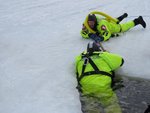 Narrowsburg
NarrowsburgLight Rain Fog/Mist, 43°
Wind: 8.1 mph
 Narrowsburg
NarrowsburgHIGHLAND LAKE, NY — A frigid breeze blowing across Highland Lake on March 6 did not deter members of the Sullivan County Dive and Rescue Team from completing the on-ice portion of a multi-day …
Stay informed about your community and support local independent journalism.
Subscribe to The River Reporter today. click here
This item is available in full to subscribers.
Please log in to continue |

HIGHLAND LAKE, NY — A frigid breeze blowing across Highland Lake on March 6 did not deter members of the Sullivan County Dive and Rescue Team from completing the on-ice portion of a multi-day rescue drill. Following the drill and classroom training, six new members were certified as level-one ice rescue technicians.
Highland Lake, Youngsville, Fallsburg, Narrowsburg, Lava, Neversink, Monticello, Grahamsville and Wurtsboro fire departments, along with the Cochecton Ambulance Corps, were all on-site for the event. In total, 15 of the 40 fire departments in Sullivan County participated in dive rescue activities.
According to team captain Joe Ratner of the Youngsville Fire Department, the team consists of 30 certified divers and about 30 surface-support people.
Co-captain Warren Wagner, who is also chief of the Highland Lake Fire Department, said that 11 of the certified divers come from Highland Lake. Even though, at the time of a call, rescuers respond from all over the county, it is fortunate that so many are from the Highland Lake area, since it is one of the busiest regions for rescue calls due to its concentration of lakes and rivers.
There are four levels of certification for rescue personnel. The first, basic open water certification, is achieved after a half-dozen classroom sessions and up to five pool sessions, followed by three or four open water dives and a final dive that occurs at Dutch Springs near Bethlehem, PA. In addition to victim-rescue operations, the course covers various diver-distress scenarios.
Actual rescue operations require a minimum team of five, three of whom are certified divers and two surface-support personnel. Under normal circumstances, one diver enters the water first, harnessed, tethered and equipped with a contingency air bottle. The second diver acts as a backup diver: They are suited up, in the water, harnessed, tethered and ready to respond in the case of any potential emergency experienced by the primary diver in the water. The divers and surface-support personnel communicate via hand signals through the rope systems. A third diver is also suited up in the event the backup diver needs to be deployed.
Searches are highly controlled, with the support personnel, known as tenders, documenting the location, search patterns and environmental conditions by which the search is conducted. Such documentation is useful should the need to recreate the search be necessary in the case of a civil or criminal matter.
Just in the last several months, the team has responded to some interesting situations. Last summer, it was called to Swan Lake where a fisherman had detected, through its depth-finding equipment, a submerged vehicle. The vehicle was eventually raised out of the water where it was determined to have been stolen and launched out into the water from a raised area at a high rate of speed, where it came to rest at the bottom of the lake for many years.
Later in the summer, a 26-foot boat was raised from Swinging Bridge Reservoir. This rescue was the first in which an airbag system was employed to raise the vessel. The airbag system was a donation from Prestige Towing & Recovery of Monticello.
Following this incident, on a bitter cold and windy day in December, the team was dispatched to assist the Monticello Fire Department with a rescue operation for a missing boater who had launched a sailboat, also at Swinging Bridge Reservoir. Neighbors had noted the boater on the water earlier in the day and called in the emergency when he could no longer be seen. Dealing with whitecaps of almost two feet, rescue personnel from White Lake and Kauneonga Lake found the boat about a mile away from where they found the boater, who was fortunately wearing a lifejacket. Hypothermic and unconscious, he was pulled from the water by members from the White Lake Fire Department. The man recovered.
Of the fleet of rescue boats operated by the various departments, only Highland Lake’s and Lumberland’s are fully equipped for night rescue. The White Lake, Rock Hill and Kauneonga fire departments also have boats, as does Narrowsburg, which was gifted an inflatable boat from the National Park Service.
Despite the name Sullivan County Dive and Rescue Team, the county provides no funding for such rescue operations, a situation that dates back to the team’s inception in the early ‘90s. Each participating fire department provides the funds for its boat and dive equipment. The cost to outfit a diver can be as high as $6,000, with most, if not all, of the equipment being bought from the diver’s personal funds. The team raises donations through a solicitation letter and holding a coin toss in August of each year. Those funds go to pay for their insurance and savings towards training courses. In October, training funds were used to certify 10 divers over a four-day course in underwater vehicle extrication and recovery.
Comments
No comments on this item Please log in to comment by clicking here